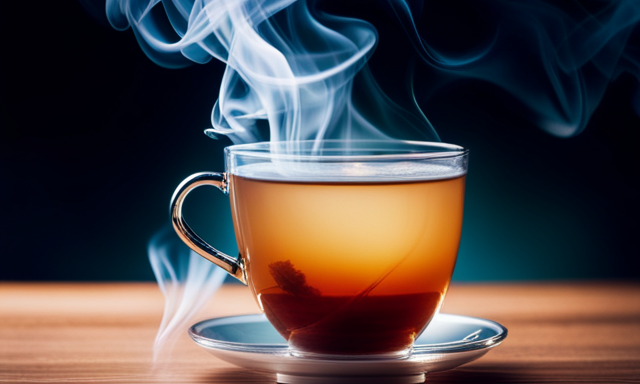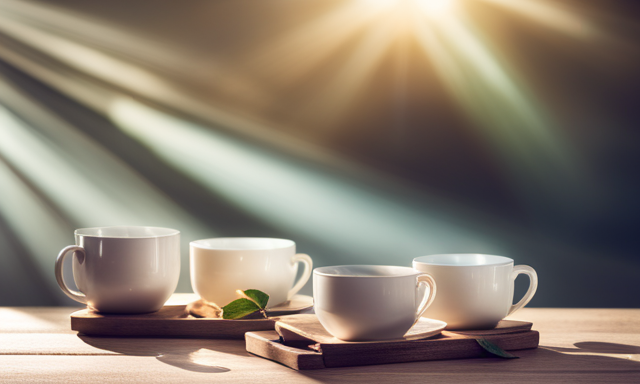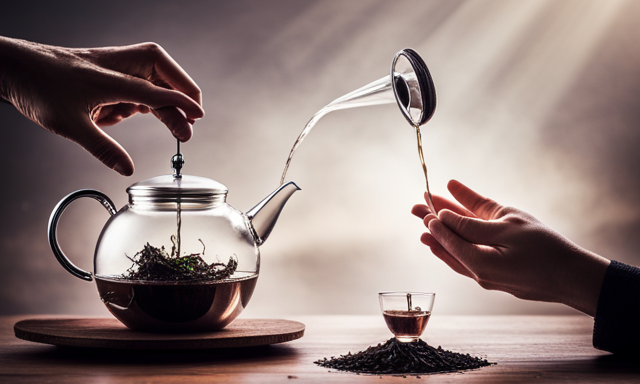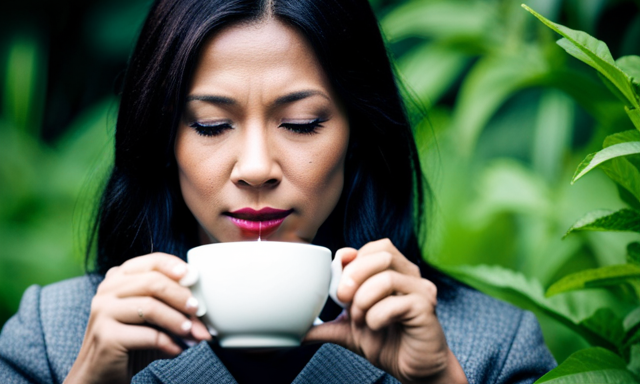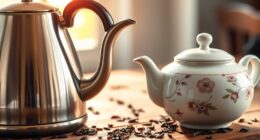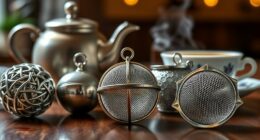I’ve always been a tea lover, and one of my favorite types of tea is oolong. Its unique flavor and aroma make it a delightful beverage to enjoy any time of the day. But have you ever wondered how long oolong tea stays fresh?
Well, let me share with you what I’ve learned. Oolong tea, like any other tea, has a shelf life, and understanding its freshness is crucial to ensure you’re getting the best cup of tea possible.
In this article, we’ll explore the factors that affect oolong tea’s freshness, proper storage techniques, signs of spoiled tea, and how to extend its shelf life. We’ll also dive into the difference between fresh and stale oolong tea and the aging process that some teas undergo.
So, whether you’re a seasoned oolong tea drinker or just starting to explore this wonderful beverage, read on to discover everything you need to know about the shelf life of oolong tea.
Key Takeaways
- The shelf life of oolong tea is up to two years.
- Proper storage in an airtight container in a cool, dry place away from strong odors is crucial to maintain the tea’s quality.
- Direct sunlight should be avoided as it can degrade the tea leaves.
- Refrigeration or freezing should be avoided as it can alter the flavor of oolong tea.
Shelf Life of Oolong Tea
Oolong tea can last for up to two years when stored properly. The shelf life of oolong tea is influenced by several factors that affect its flavor profile. One of the main factors is the level of oxidation during processing. Oolong tea that is less oxidized tends to have a lighter and fresher taste, while heavily oxidized oolong tea develops a richer and more robust flavor.
Another factor is the quality of the tea leaves used. Higher quality leaves tend to retain their freshness and flavor for a longer period of time. Aging oolong tea can also have its benefits. As it ages, the flavors mellow and become more complex, resulting in a smoother and more enjoyable cup of tea.
Moving on to factors that affect oolong tea’s freshness…
Factors that Affect Oolong Tea’s Freshness
What factors determine the freshness of this delicious tea? When it comes to oolong tea, there are several key factors that can affect its freshness and flavor.
Firstly, the quality of the tea leaves plays a significant role. High-quality leaves that’re harvested at the right time and processed correctly will result in a more flavorful and longer-lasting tea.
Additionally, the way oolong tea is stored can greatly impact its freshness. It’s important to keep the tea in an airtight container, away from light, moisture, and strong odors. Proper storage techniques, such as storing it in a cool and dry place, can help preserve its flavor and aroma for a longer period.
By following these oolong tea storage tips and taking care of the tea, you can ensure that it stays fresh and enjoyable for a longer time.
Proper Storage Techniques
When it comes to properly storing oolong tea, there are two key points to keep in mind: keep it away from light and heat, and use airtight containers. Light and heat can both degrade the quality and flavor of oolong tea, so it’s important to store it in a cool, dark place.
Airtight containers help to preserve the freshness and aroma of the tea by preventing exposure to air and moisture. By following these storage techniques, you can ensure that your oolong tea stays fresh and flavorful for as long as possible.
Keep Away from Light and Heat
To ensure the freshness and flavor of your oolong tea, you’ll want to keep it away from light and heat. Proper storage techniques play a crucial role in preserving the quality of your tea.
Here are three reasons why you should store your oolong tea away from light and heat:
- Light exposure can degrade the tea leaves and cause oxidation, leading to a loss of flavor and aroma.
- Heat accelerates the breakdown of essential oils and compounds in oolong tea, resulting in a dull taste.
- Prolonged exposure to light and heat can also cause the tea to spoil faster, resulting in a stale and unpleasant flavor.
By understanding these potential issues, you can better protect the quality of your oolong tea.
Now, let’s move on to the next important step: using airtight containers.
Use Airtight Containers
Make sure you seal your oolong tea in airtight containers to preserve its freshness and flavor. Choosing the proper container is crucial for maintaining optimal freshness.
Look for containers that are specifically designed to block out air and moisture, such as glass jars with tight-fitting lids or vacuum-sealed bags. These containers will help to prevent the tea from being exposed to oxygen, which can cause it to lose its aroma and taste over time.
By keeping your oolong tea in an airtight container, you can extend its shelf life and ensure that it remains as flavorful as possible.
Now, let’s move on to the next section and discuss the signs of spoiled oolong tea.
Signs of Spoiled Oolong Tea
If you’re not careful, you could end up drinking spoiled oolong tea that’ll leave a bitter taste in your mouth. Signs of spoilage in oolong tea can be easily detected if you know what to look for. Here are five indicators that your oolong tea may have gone bad:
- Mold or unusual growth: Any presence of mold or other strange growth is a clear sign of spoilage.
- Foul odor: Spoiled oolong tea will emit a strong, unpleasant smell.
- Off taste: If your oolong tea tastes sour, rancid, or significantly different from its usual flavor, it may have spoiled.
- Discolored leaves: Oolong tea leaves should have a vibrant color. Discoloration indicates spoilage.
- Presence of insects or pests: If you find any bugs or pests in your oolong tea, it’s a sure sign of spoilage.
To avoid encountering these issues, it’s essential to store your oolong tea properly.
Now, let’s move on to how to extend the shelf life of oolong tea.
How to Extend the Shelf Life of Oolong Tea
One way to keep your oolong tea fresh for longer is by properly storing it. This is essential in extending the freshness and preserving the flavor of your tea.
To ensure the best quality, store your oolong tea in an airtight container, away from direct sunlight and moisture. This will prevent exposure to air, light, and humidity, which can all lead to a decline in flavor and aroma.
Additionally, it’s recommended to store your oolong tea in a cool and dry place to maintain its freshness. By following these storage guidelines, you can enjoy the full flavor of your oolong tea for an extended period.
Now, let’s delve into the common mistakes to avoid when handling oolong tea.
Common Mistakes to Avoid
Avoiding these common mistakes will help you savor the rich flavor and aroma of your oolong tea for an extended period.
When it comes to the shelf life of oolong tea, many people have misconceptions based on their experience with green tea. Green tea is known to have a shorter shelf life compared to oolong tea. However, oolong tea can still lose its freshness if it is not properly stored.
One common mistake is exposing the tea to air, light, and moisture. These elements can accelerate the tea’s oxidation process and result in a shorter shelf life.
Another mistake is storing oolong tea in the refrigerator, as the fluctuating temperature can cause condensation and spoil the tea.
Understanding these common misconceptions about tea freshness will help you differentiate between fresh and stale oolong tea, which we’ll discuss in the next section.
Difference Between Fresh and Stale Oolong Tea
To truly taste the tantalizing transformation of oolong tea, you must swiftly spot the stark disparity between the succulent savor of fresh leaves and the lackluster flavor of stale steepings.
The freshness indicators of oolong tea include the appearance, aroma, and taste. Fresh oolong tea leaves are vibrant in color, emitting a fragrant aroma that’s floral and fruity. When brewed, it offers a smooth and complex flavor profile with subtle hints of sweetness.
On the other hand, stale oolong tea leaves appear dull and lifeless, lacking the captivating aroma and delicate taste of their fresh counterparts. By drinking oolong tea in its freshest form, you can fully experience its numerous benefits, including improved digestion, boosted metabolism, and enhanced mental alertness.
As we delve into the oolong tea aging process, we’ll uncover the fascinating changes that occur as tea leaves mature.
Oolong Tea Aging Process
As we discussed previously, the difference between fresh and stale oolong tea lies in its flavor profile. Now, let’s delve into the fascinating process of aging oolong tea.
Oolong tea, like fine wine, undergoes an oxidation process that enhances its flavor and aroma over time. This oxidation occurs naturally as the tea leaves are exposed to air and moisture. As the tea ages, the flavors develop and deepen, resulting in a more complex and rich taste.
The length of the aging process can vary, but typically, oolong tea is aged for at least a year to allow for optimal flavor development. During this time, the tea undergoes subtle changes, offering a unique drinking experience.
Now, let’s move on to the best practices for brewing oolong tea.
Best Practices for Brewing Oolong Tea
When brewing oolong tea, it’s important to find the perfect balance of steeping time and water temperature to create an exquisite cup of tea. The best water temperature for brewing oolong tea is typically between 185°F and 205°F (85°C – 96°C). Steeping time can vary depending on the type of oolong tea, but generally, a shorter steeping time of 2-3 minutes is recommended for lighter oolongs, while darker oolongs may require a longer steeping time of 4-5 minutes.
To help you get the perfect brew, here’s a table to guide you:
| Type of Oolong Tea | Best Water Temperature | Steeping Time |
|---|---|---|
| Light Oolong | 185°F – 195°F (85°C – 90°C) | 2-3 minutes |
| Dark Oolong | 195°F – 205°F (90°C – 96°C) | 4-5 minutes |
Finding the right balance of water temperature and steeping time will ensure that you enjoy the full flavor and aroma of your oolong tea. Now let’s move on to discussing the shelf life of oolong tea.
Final Thoughts on Oolong Tea’s Shelf Life
If you’re wondering how long you can store oolong tea, it’s worth noting that on average, oolong tea can remain fresh for up to two years when stored properly in an airtight container. The shelf life of oolong tea can vary depending on factors such as the quality of the tea leaves and the storage conditions.
To ensure the longevity of your oolong tea, here are some best practices for storing it:
- Keep it in an airtight container to prevent exposure to air and moisture.
- Store it in a cool, dry place away from strong odors.
- Avoid direct sunlight, as it can degrade the tea leaves.
- Do not refrigerate or freeze oolong tea, as it can alter the flavor.
- Consider using opaque containers to block light.
By following these storing methods, you can maximize the shelf life of your oolong tea and continue to enjoy its rich flavor and aroma for a longer period of time.
Frequently Asked Questions
Can I still drink oolong tea that has expired?
Expired oolong tea may not be harmful, but it may lose some of its health benefits and flavor. It’s generally best to consume tea before its expiration date to enjoy its full potential.
How long does oolong tea typically stay fresh if stored properly?
Oolong tea typically stays fresh for up to 2 years when stored properly. The shelf life can be extended by keeping it in an airtight container, away from light, heat, and moisture.
What are the main factors that can cause oolong tea to spoil quickly?
The main factors that can cause oolong tea to spoil quickly are poor storage conditions, such as high temperatures and humidity, exposure to air and moisture, and the presence of contaminants.
Are there any specific containers or packaging materials that are recommended for storing oolong tea?
When it comes to storing oolong tea, using the right containers and packaging materials can make all the difference. Recommended storage containers include airtight tins or ceramic jars, while the best packaging materials are those that block out light and moisture.
Is there a noticeable difference in taste between freshly brewed oolong tea and tea that has been stored for a long time?
There is a noticeable difference in taste between freshly brewed oolong tea and aged tea. Aging allows for flavor development, resulting in deeper, richer flavors and a smoother, more mellow taste profile.
Conclusion
After diving into the world of oolong tea and exploring its shelf life, storage techniques, and signs of spoilage, one thing is clear: there’s nothing quite like a fresh cup of oolong tea.
The contrast between a cup of freshly brewed oolong tea and one that has gone stale is truly remarkable.
By following proper storage techniques and paying attention to the signs of spoilage, you can extend the shelf life of your oolong tea and continue to enjoy its rich flavor and aroma.
So, go ahead, savor every sip of this delightful tea and make the most of its freshness while it lasts.

